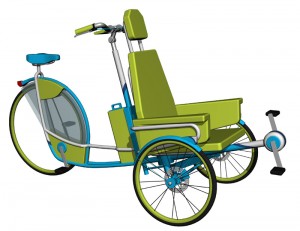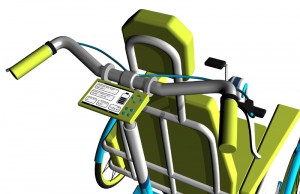 DuoCycle is a student project by Wim Bussels, who is currently studying industrial design at MAD Faculty in Genk, Belgium. Wim’s upright/recumbent tricycle (with a rear hubless wheel) allows a person with disabilities to ride in tandem with an accompanist who controls the steering and braking. Both riders can pedal, so the disabled rider to contribute as much (or as little) as he or she chooses to the power generation. His or her pedaling efforts directly charge the trike’s battery, and the power output is displayed on the integrated computer.
DuoCycle is a student project by Wim Bussels, who is currently studying industrial design at MAD Faculty in Genk, Belgium. Wim’s upright/recumbent tricycle (with a rear hubless wheel) allows a person with disabilities to ride in tandem with an accompanist who controls the steering and braking. Both riders can pedal, so the disabled rider to contribute as much (or as little) as he or she chooses to the power generation. His or her pedaling efforts directly charge the trike’s battery, and the power output is displayed on the integrated computer.
 You can read more about the DuoCycle, and see several additional 3d CAD images and sketches, on Wim’s website for the project.
You can read more about the DuoCycle, and see several additional 3d CAD images and sketches, on Wim’s website for the project.

Leave a Reply to station44025 Cancel reply